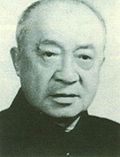
Wan Guchan
Encyclopedia

Chinese people
The term Chinese people may refer to any of the following:*People with Han Chinese ethnicity ....
filmmaker. Born in Nanjing
Nanjing
' is the capital of Jiangsu province in China and has a prominent place in Chinese history and culture, having been the capital of China on several occasions...
, China
China
Chinese civilization may refer to:* China for more general discussion of the country.* Chinese culture* Greater China, the transnational community of ethnic Chinese.* History of China* Sinosphere, the area historically affected by Chinese culture...
, he was one of the Wan brothers
Wan brothers
The Wan Brothers were born in the early 20th century in Nanjing, China. They became the founders and pioneers of the Chinese animation industry and made the first Asian animation feature-length film, Princess Iron Fan in 1941.-Background:...
who pioneered the Chinese animations industry.
Early history
Wan Guchan joined his twin brother Wan LaimingWan Laiming
Wan Lai-Ming was born in Nanjing, China. He was one of the Wan brothers who pioneered the Chinese animation industry, and became China's first animator. As the director of the Shanghai Animation Film Studio, he would raise the standard to International level before other historical events...
in most of the animation projects and experimentations.
Achievements
Throughout his career, Wan Guchan would be the closest to Wan Laiming in assisting him in all major projects. In 1958, he would be credited as the innovator of a new paper-cut method. The technique was demonstrated in the animation Pigsy Eats WatermelonPigsy Eats Watermelon
Pigsy Eats Watermelon is a chinese animation produced at the Shanghai Animation Film Studio by Wan Laiming and Wan Guchan. It is also referred to as "Mr. Pig Eats Watermelon" or "Zhu Bajie Eats Watermelon".-Story:...
.
Wan Guchan would also take part in the 1964 film Havoc in Heaven
Havoc in Heaven
Havoc in Heaven , also known as Uproar in Heaven, is a Chinese animated feature film directed by Wan Laiming and produced by all four of the Wan brothers. The film was created at the height of the Chinese animation industry in the 1960s, and received numerous awards...
, which would bring China recognition internationally.

